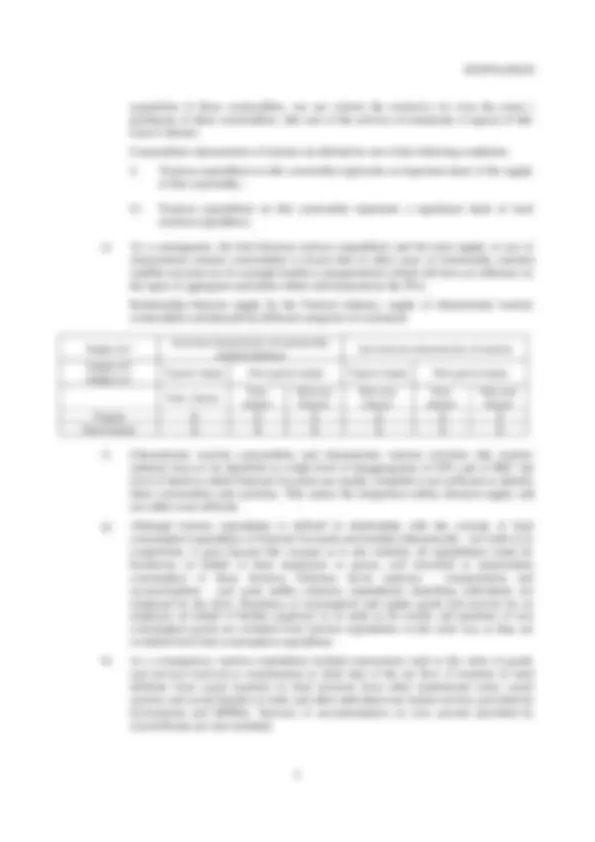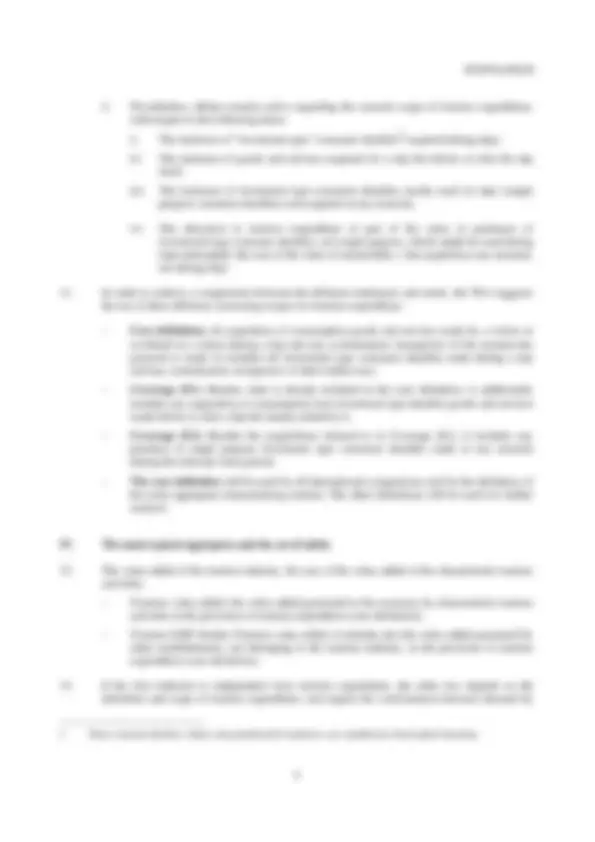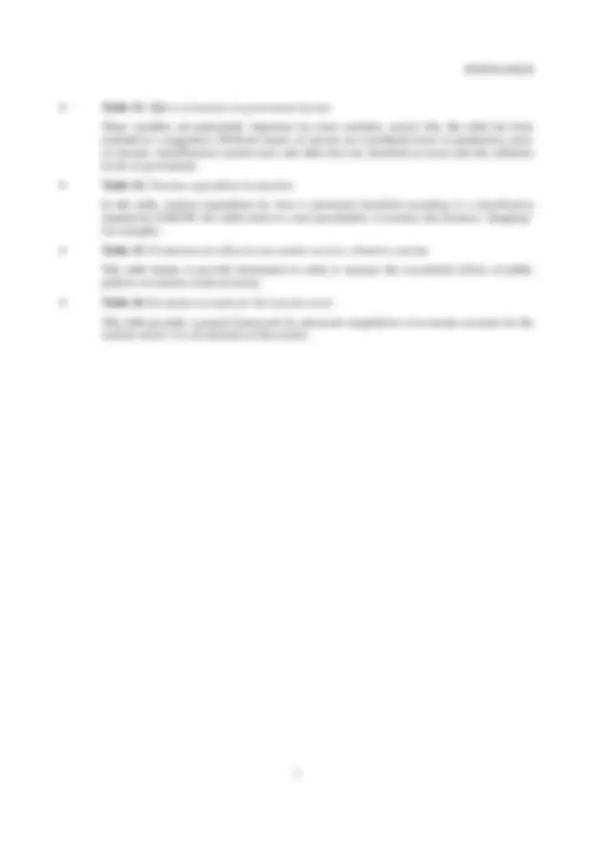






Study with the several resources on Docsity

Earn points by helping other students or get them with a premium plan


Prepare for your exams
Study with the several resources on Docsity

Earn points to download
Earn points by helping other students or get them with a premium plan
Community
Ask the community for help and clear up your study doubts
Discover the best universities in your country according to Docsity users
Free resources
Download our free guides on studying techniques, anxiety management strategies, and thesis advice from Docsity tutors
The conceptual framework for a Tourism Satellite Account (TSA) as presented by Marion Libreros of the World Tourism Organization. The TSA aims to facilitate the analysis of tourism demand, commodities, and industries. definitions of tourism and tourism expenditure, forms of tourism, and the relationship between supply by the tourism industry, supply of characteristic tourism commodities, and demand by different categories of consumers. It also discusses the importance of identifying characteristic tourism commodities and activities at a high level of disaggregation and the challenges of defining the scope of tourism expenditure.
Typology: Study notes
1 / 8

This page cannot be seen from the preview
Don't miss anything!





Organisation de Coopération et de Développement Economiques Organisation for Economic Co-operation and Development
STATISTICS DIRECTORATE
National Accounts
Château de la Muette, Paris 22-25 September 1998 Beginning at 9.30 a.m. on the first day
Agenda item: 3
A conceptual framework for a Tourism Satellite Account
Marion Libreros World Tourism Organization
Marion LIBREROS World Tourism Organization
I. Main definitions^1
− Domestic tourism involves visitors travelling within their country of residence;
− Outbound tourism involves residents of an economy travelling in a different economic territory; − Inbound tourism involves non residents of an economy travelling within the economy of compilation;
II Need for a TSA
1 From Recommendations on Tourism Statistics United Nations- World Tourism Organization 1994 Series M No 83.
acquisition of these commodities, nor are visitors the exclusive (or even the main..) purchasers of these commodities. (the case of the services of restaurants is typical of this kind of debate). Commodities characteristic of tourism are defined by one of the following conditions: i) Tourism expenditure on this commodity represents an important share of the supply of this commodity;
ii) Tourism expenditure on this commodity represents a significant share of total tourism expenditure;
e) As a consequence, the link between tourism expenditure and the total supply or use of characteristic tourism commodities is looser than in other cases of functionally oriented satellite accounts (as for example health or transportation) which will have an influence on the types of aggregates and tables which will characterize the TSA. Relationship between supply by the Tourism industry, supply of characteristic tourism commodities and demand by different categories of consumers
Supply by? Activities characteristic of tourism (thetourism industry) Activities not characteristic of tourism Supply of? Supply to? Typical output^ Non typical output^ Typical output^ Non typical output Tour. charact. (^) charact.Tour. Non tour.Charact. Non tour.charact. charact.Tour. Non tour.charact. Visitors X X X X X X Non Visitors X X X X X X
f) Characteristic tourism commodities and characteristic tourism activities (the tourism industry) have to be identified at a high level of disaggregation of CPC and of ISIC: the level of detail in which National Accounts are usually compiled is not sufficient to identify these commodities and activities. This makes the integration within classical supply and use tables more difficult. g) Although tourism expenditure is defined in relationship with the concept of final consumption expenditure of National Accounts and includes (theoretically - see i))all of its components, it goes beyond this concept as it also includes all expenditures made by businesses on behalf of their employees or guests, and classified as intermediate consumption of these business (business travel expenses - transportation and accommodation - and some public relations expenditures benefiting individuals not employed by the firm). Purchases of consumption and capital goods and services by an employee on behalf of his/her employer or in order to be resold, and purchase of non consumption goods are excluded from tourism expenditure, in the same way as they are excluded from final consumption expenditure. h) As a consequence, tourism expenditure includes transactions such as the value of goods and services received as remuneration in kind; that of the net flow of transfers in kind different from social transfers in kind received from other institutional units; social security and social benefits in kind; and other individual non market services provided by Government and NPISHs. Services of accommodation on own account provided by second homes are also included.
i) Nevertheless, debate remains active regarding the concrete scope of tourism expenditure, with respect to the following items:
i) The inclusion of "investment type" consumer durables^2 acquired during trips; ii) The inclusion of goods and services acquired for a trip but before or after the trip itself; iii) The inclusion of investment type consumer durables mostly used on trips (single purpose consumer durables) and acquired at any moment;
iv) The allocation to tourism expenditure of part of the value of purchases of investment type consumer durables, not single purpose, which might be used during trips (principally the case of the value of automobiles..) but acquired at any moment, not during trips.
− Core definition: all acquisition of consumption goods and services made by a visitor or on behalf of a visitor during a trip and stay at destination, irrespective of the moment the payment is made (it includes all investment type consumer durables made during a trip and stay at destination, irrespective of their further use). − Coverage (E1): Besides what is already included in the core definition, it additionally includes any acquisition of consumption (non investment type durable) goods and services made before or after a trip but clearly related to it. − Coverage (E2): Besides the acquisitions referred to in Coverage (E1), it includes any purchase of single purpose investment type consumer durables made at any moment during the reference time period.
− The core definition will be used for all international comparisons and for the definition of the main aggregates characterizing tourism. The other definitions will be used for further analysis.
IV. The main typical aggregates and the set of tables
2 Those consumer durables, which, when purchased by businesses, are considered as fixed capital formation.
The information of the three previous tables is summarized and presented differently, to be more easily integrated into the sequence which follows.
These tables present modified versions of supply and use tables, where supply by domestic producers is still presented as a unique vector, narrowing the presentation towards one which makes easier the comparison with a view of tourism from a supply point of view.
This table is the core of the TSA, where supply by detailed characteristic and non detailed non characteristic activities is compared to tourism expenditure. This table provides the information for the compilation of tourism value added and of tourism GDP.
This table presents employment expressed in terms of number of jobs, total hours worked and status in employment for detailed characteristic tourism activities. Information is also provided to estimate, via the tourism ratio in value added, tourism generated jobs and hours worked total and by activity in characteristic tourism activities.
a) Tourism related net acquisition of produced non financial assets b) Specific produced fixed assets - stocks and annual changes c) Net acquisition of non financial assets by the Tourism Sector
These tables aim at measuring variables related to investment, associated to tourism. Table c. belongs to an extension of the TSA to include institutional accounts.
a. Imports and exports of goods and services generated by tourism
b. Tourism Balance of Payments The TSA provides a new insight on the effect of tourism on Balance of Payments, as it allows to take into account different degrees of induced acquisition of imports by resident providers of commodities to visitors.
These variables are particularly important for some countries, reason why this table has been included as a suggestion. Different classes of income are considered (taxes on production, taxes on income, miscellaneous current taxes and other fees not classified as taxes) and also different levels of government.
In this table, tourism expenditure by form is presented classified according to a classification inspired by COICOP, but which sticks to some peculiarities of tourism (the function "shopping" for example).
This table intents to provide information in order to measure the cost-benefit effects of public policies on tourism on the economy.
This table provides a general framework for advanced compilations of economic accounts for the tourism sector: it is an extension of the system.